It’s time I admit this: I’m too lazy to get Morrowind Sharp setup on my new PC to complete Bloodmoon and Tribunal. If I wait for much longer, I’ll forget the most important part: that I have finally gotten closer to becoming a real gaming boy by finally completing The Elder Scrolls: Morrowind. And yes, I used mods. Cry about it.
‘tis the Year of Our Lord 2024. Do I even need to describe the story of Morrowind? The basics are the same as of any other game in the The Elder Scrolls series: you are a prisoner, targeted by fate and destiny to accomplish great things, maybe become the mythical Nerevarine, even though you’re not aware of that. Except in Morrowind’s case, you don’t land in a fairly generic Euro-fantasy land. No, you’re set free in Vvardenfell, the weird island at the heart of the Imperial district of Morrowind.
Welcome to Morrowind. Now git.
Vvardenfell is a place overgrown with giant mushrooms as much as with trees, and travel between the cities relies as much on riding giant bugs as sailing boats. This is the ancestral land of the Dunmer – the red-eyed Dark Elves – but it is under the control of the human emperor in Cyrodil. On the other hand, the grasp of occupying the Cyrodilic Empire is somewhat tenuous outside of their forts and friendly towns. Everyone is scheming against everyone while the devil Dagoth Ur strikes Dunmer with maddening visions. From his lair in the Red Mountain, the volcano at the center of the island, he also sends Blight storms that can strike anyone with awful diseases.
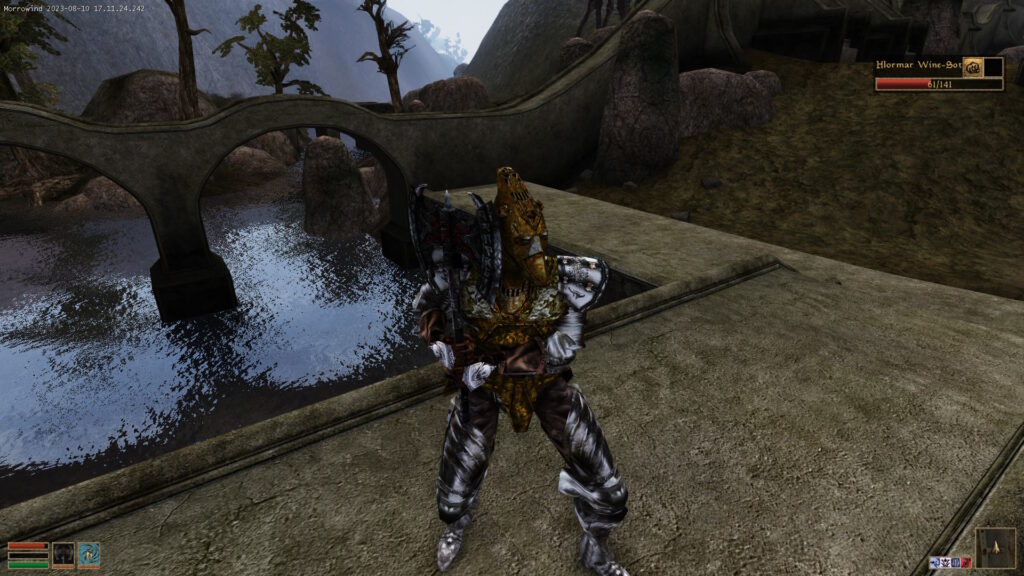
This is why people remember Morrowind. Where most games in fantasy settings try to ape Tolkien and end up closer to medieval-ish grayness of Greyhawk (the DnD setting only three OSR beardos pretend to like), Morrowind takes the train off the tracks and for a wild ride in the mountains.
The Empire may construct conventional European buildings, but in armament and naming, it’s Roman. The Tamrielic Empire may be bringing a measure of peace and stability to Vvardenfelll, but they’re also allowing slavery – which Dunmer claims is traditional and is aimed mostly at the feline Khajiit and reptilian Argonians – to continue. The three Great Houses – Dark Elven nobility – present on the island are plotting against everyone, including each other and within themselves.
The Telvanni, the wizardly Great House, literally doesn’t know the difference between right and wrong. The Mage and Fighter Guilds are basically protection rackets. There’s a racist Dunmer mafia and a legally sanctioned traditional guild of assassins. You can kill a guy in the middle of the street and everything will be fine as long as you present the writ to the officers coming to arrest you.
There are also steampunk ruins of the mysteriously-vanished Dwemer (dwarves), at least three distinct Dunmer architectural styles, and demonic ruins left over from the daedra-worship days. The ecology of the island is weird, and only the rat is a typical fantasy critter that you’ll encounter-
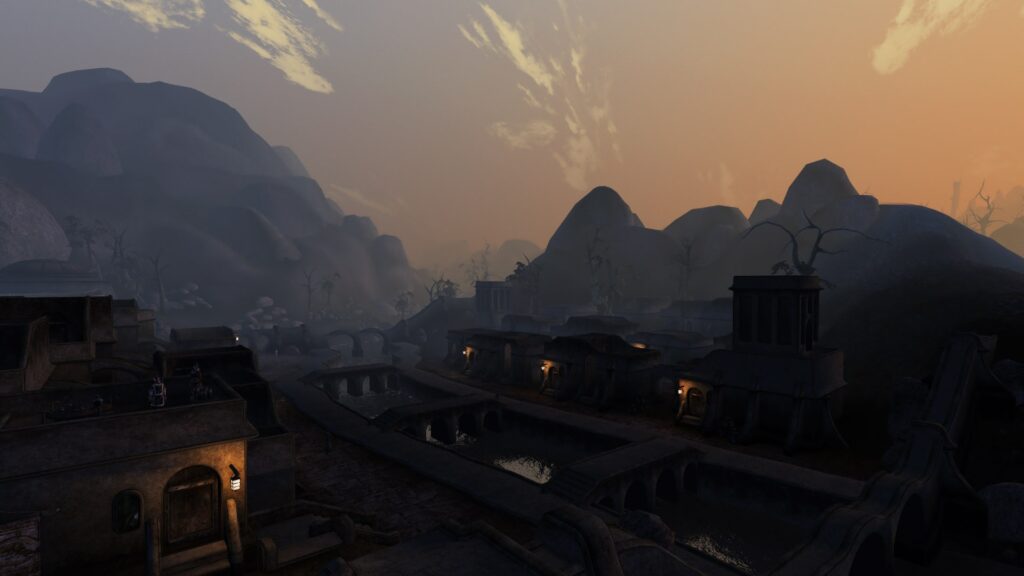
The point I’m trying to make is that Morrowind, as a setting, is unique, is weird. It’s weird, it’s weird, it’s weird, it’s weird, it’s weird, it’s weird, it’s weird, it’s weird, it’s weird, it’s weird, it’s weird, it’s weird, it’s weird, it’s weird, it’s weird, it’s weird, it’s weird, it’s weird, it’s weird, it’s weird. That should about cover it – and as you get deeper into the plot, you realize that it’s not not weirdness-for-weirdness’ sake.
The real reason why the Dwemer disappeared
What Morrowind isn’t, especially in 2024, is a good game. The only good design decision is to make it a first-person RPG – a lot more impactful than going isometric – but it’s just a continuing feature of the series. Almost immediately, you’ll notice that combat mechanics are whack. You’re stabbing a little Kwama worm with a dagger and you’re missing through no fault of your own. This will also happen to your best-aimed spells and even point-blank ranged attacks!
That’s because someone at Bethesda had the genius brain idea – or maybe it was inherited from previous titles – to make your first person combat be actually dependent on off-screen dice rolls. So you’re stuck in a situation where you may thrust and parry and move around, but whether you hit – and how much damage you deal – is dependent on dice rolls based on your skills. It feels so bad that I remember, 20 years hence, dying to a Kwama Forager just outside of Seyda Neen.
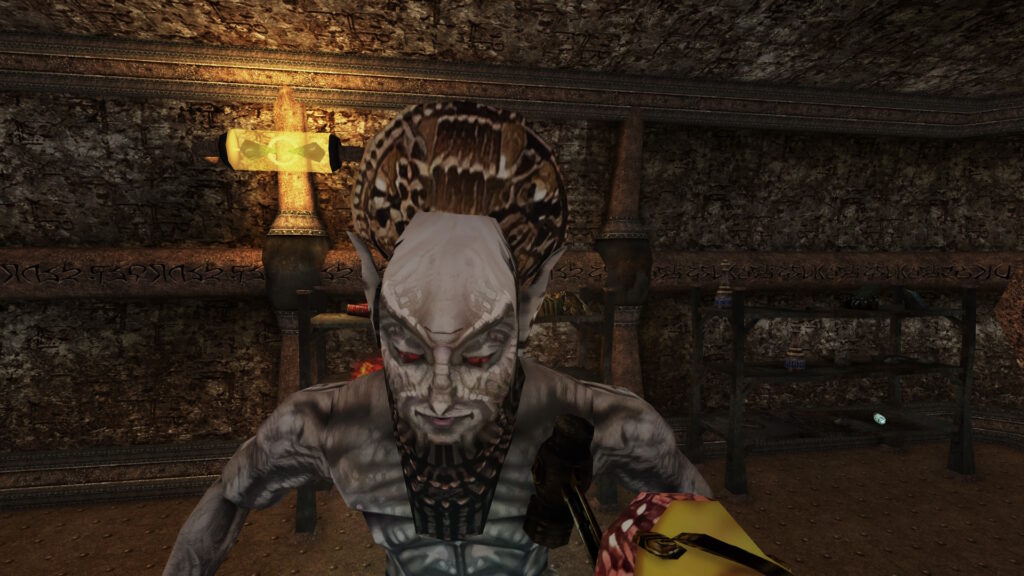
What I had forgotten was fucking stamina. It’s one of those features that haven’t reached meme status, but the stamina bar will be your number 1 enemy for at least half of the game. Around that time, you should be able to find the means to permanently solve stamina regeneration as an issue.
But before that point, you will suffer. Half of the issue comes from how stamina dictates battles – you run out of breath nearly immediately, which tanks your damage. The other half deals with exploration. Want to move at more than snail’s pace? Run. Running? You’re out of breath within 5 seconds.
You can’t buy a horse. Fast travel is only possible via boats or giant bugs, and teleportation spells are very limited in what they can do. Even flying keys off your run speed.
I started consuming enough stamina potions to upset the economy. An alchemist selling naught but stamina potions could buy a house in Hlaalu Plaza in Vivec and pay in cash. The hotkey for stamina potions sees more action than the one for health.
So of course The Sarmat Todd Howard would bring back this devil’s asshole of a mechanic in Starfield, a game that is otherwise anti-Morrowind in every which way.
Of bespoke fireballs
Magic can do everything in Morrowind: summoning creatures and armors, dealing damage, restoring fucking stamina, flying, walking on water, breathing under water… But it has also been bludgeoned by the simulationist stick. If something exists, we must have spells that affect it.
But do we really need spells that damage an enemy’s Personality stat? This isn’t Dungeons and Dragons, a cleric isn’t reliant on Charisma for casting. Their face doesn’t become more punchable. In fact, any stat-damage spell is, for the player, inferior to direct damage (though I’m sure tricks and exploits exist).
And there’s so many fucking spells in this game! It’s to account for the fact that they don’t really scale as you level up, so you need a new Firebolt-type spell for every 20 points you get in Destruction class. You can choose to forget spells just to get rid of the chaff.
You can also create spells and enchantments in Morrowind by mixing and matching effects from known spells. Do you want to make some superkill spell that causes all the elemental damage effects at once? You can! Just have enough skill and Magicka (mana) to cast it. Via enchantments, you can even tie such spells to pieces of gear, in which case it will use the item’s magical charge – that’s the pro-strat way to go around Magicka and skill limitations.
You can even permanently enhance an item if you get a powerful enough soul (think Golden Saint or better) captured. However, it is prohibitively expensive to do at a vendor and very difficult as a DIY project.
So, you know, you’ll save it for a permanent stamina regeneration enhancement.
If you know the stamina regeneration spell. That’s the trick about enchantment. You can pay a wizard to enchant your stuff for you. It’s 100% successful, just expensive. But what if you’re not a spellcaster, what if you chose to be a warrior? An option to base enchantments on owned spell scrolls or enchanted items would have been nice.
The best thing you can say about spells in Morrowind is that the system wasn’t designed by cowards. In Oblivion, it’s trivially easy to make a player slog through every fortress and Oblivion citadel as the game doesn’t feature flight, hover or super jump (note: save from fall damage not included).
In Morrowind, all of those options are at your fingertips for exploration and navigation. I used long-lasting flight spells and Boots of Blinding Speed – which are very literally blinding – to soar around Vvardenfell via instrument-assisted flight. The Nerevarine doesn’t have to know where it isn’t.

Punching n’wah
Another design idea that was too brave to survive to later titles? The enemies don’t level scale in Morrowind. So as a baby player, you can readily run into enemies that will squash you like a bug. As a high level character, you may still start some low-level quests where you’ll just disintegrate the opposition. There’s no rubber banding and it fucking rocks, you will never be accosted by a highwayman in Daedric Armor.
Unfortunately, some enemies deal stat-damage, the most common of which is the strength-sapping Bonewalker. Strength also governs how much weight you can carry. As such, Bonewalkers, the favorite summon of any wizard not smart enough to be friendly, remain a huge fucking threat into the late game, moreso than the wizard himself. Of course, there are ways to restore your Strength, but you’ll still be leaving loot behind.
At the end of the day, there are two issues with Morrowind enemies: Cliff Racers and Slaughterfish. Cliff Racers are bad enough to have achieved meme status. They spawn in such numbers that any trek in the wilderness will involve killing upwards of three. I came to hate them enough that I wouldn’t even soultrap them to demonstrate my disdain.
Even if you’re aiming for a pure vanilla experience in Morrowind, you should mod the Cliff Racers numbers down, it’s the kind of bullshit that should have been fixed in a patch.
Now, Slaughterfish are more of a brainworm thing for me as it’s one of the two enemies you’ll encounter in water. There’s quite a lot of water and underwater navigation in Morrowind, and constantly fighting slaughterfish (and baby slaughterfish) gets stale, fast.
Fresh out of 11-foot ladders
Another thing about exploration is breaking in and looting. A big issue in Morrowind is that most stuff in cities isn’t marked as belonging to anyone, so you can steal trinkets like nobody’s business. This is annoying, especially when you’re a desperate lil’ hobo scrounging gold (for stamina potions). And there’s so much clutter to steal! For negligible financial gains! No wonder Morrowind Sharp mods in ownership.
We should also mention lock picking and trap defusing. They are not minigames, they’re just straight-up dice tosses. So you get the highest-level lockpick you can and if the game doesn’t tell you that the lock is above your level, just plug away at it until fortune smiles at you. The only player-skill related aspect is to remember to check the lock for traps with a probe beforehand. Literally the same as lockpicking, but a different tool. Other than that, it’s just endurance – or the clarity of mind to come prepared with a bunch of Ondussi’s Open Door scrolls.
Then I gradually find out that most boxes contain garbage not worth stealing or expending lockpicks on.
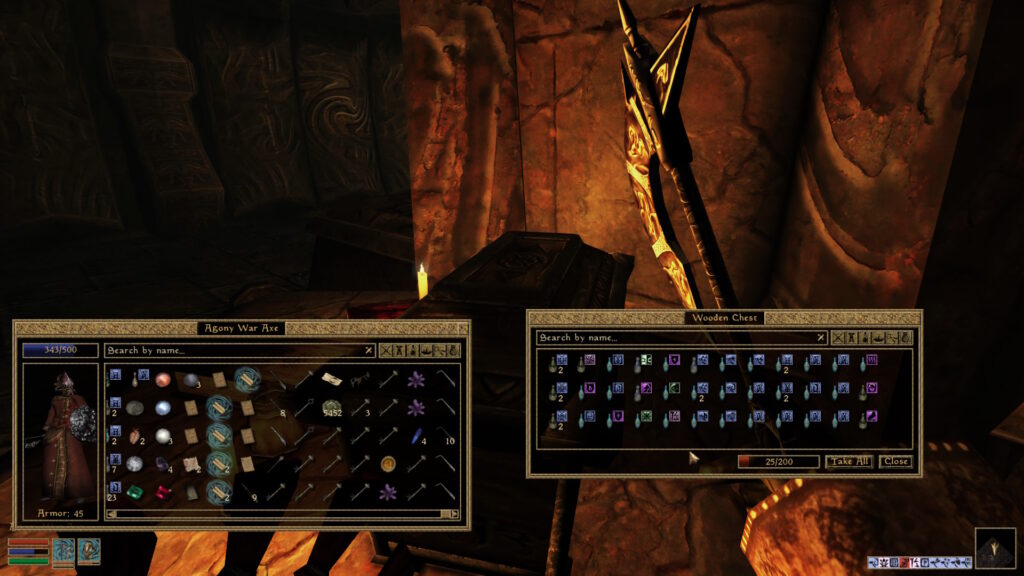
Now, think back to The Elder Scrolls V: Skyrim. As a land, Skyrim itself is a lot less fantastical than Vvanderfell. But there is one standout: most of the dungeons end up going in a circle, depositing the explorer back at the entrance. This is to save the player from backtracking. Morrowind, however, was a game made by whatever the opposite of a coward is.
The dungeons may have many entrances to award exploration, but that’s not a guarantee. Instead, the player is expected to reach the end of the Dwemer ingot road and teleport away, either via Recall or Divine/Almsivi Intervention. The later method is fairly cheap and dumps you in the nearest temple – and a temple almost invariably means a local economy robust enough to hoover up all the crap you collected before calling in Celestial Uber.
Local gamer finally finds use for brain
Actually, I kind of like not having instant fast travel in Morrowind? It is annoying at times, especially if you need to revisit places far away from striders, boats, mage guilds or temples, However, it stops you from ignoring terrain outside of the one time you needed to traverse it before reaching the fast travel marker as you would in Oblivion or Skyrim.
It’s not as convenient, but it creates verisimilitude. More than that: you also start feeling pretty smart if you manage to chain those disparate travel systems to take you where you need to go. Doubly so when you consider that boats and striders only go to their nearby counterparts. So you’re not sailing across the island in one go – no, you need to get smart with how you connect the legs of your travel.
It also made me really think about my Mark/Recall spell use. A lot of the time, I used it to get back into the lair of the assassin guild, since it’s normally annoying to reach. But there were occasions when it was necessary to mark a spot for later return – mostly to gather more loot.
Another thing about Morrowind is that it came out before the widespread adoption of quest markers. This means that the player is reliant on reading the geographical descriptions in the quest and then matching it to their surroundings. They may also be called upon to actually search a quest location for a button or an item.
Unfortunately, this relies on the description being correct and the player being right. And as well all know, players love not reading through any instructions a game provides and then getting pissy. This is a lot more likely to happen in Morrowind since the journal DOESN’T SUMMARIZE YOUR QUEST OBJECTIVES. Instead it records, verbatim, what the NPCs said, leaving you the onerous-if-verisimilitudinous task of sorting the wheat from the chaff. Personally, I could use those quest summaries, especially when the game doesn’t always record the most relevant data.

At least we have the TES wiki these days. This was especially important when one quest bid me to poison a guy’s meal. I couldn’t find a way to do it – and searching online told me to interact with his cooking pot. And this is probably one of the handful instances in the game where you’re required to do quest-specific interactions with the environment. 99% of what you do with inanimate objects in the game is open doors and boxes. The player isn’t trained to expect environmental interactions, it was the gross exception-to-the-rule.
But that is a weakness in general quest design in Morrowind – they’re just not that intricate. Go to a place. Talk to a guy. Maybe kill said guy. Go to a place. Find a thing – that thing may be in a box. You may need to kill a guy. Sometimes, if you read the wiki, you have options on what to do, but a lot of the time, it’s very straightforward. And, again, lacking in those environmental interactions that would mark the quests like something out of the ordinary.
Compare this to Oblivion – a game made by cowards. The Dark Brotherhood is an assassins guild for n’wah s‘wit, but I still remember the one quest where I had to assassinate a dude by loosening a minotaur’s head hung above his chair. Sure, the game didn’t provide much in the way of flexibility of approaches (and I’m not asking for a full Hitman experience here), but it stands out, after all these years, as probably the only Dark Brotherhood quest I remember.
And Morrowind itself could use more of the weird interactions to underline the weirdness of the setting as well as ways to manipulate NPCs as alternative (or main) ways to achieve a quest.
Non-Player CHIM
Speaking of NPCs – or rather speaking to NPCs – all the dialogue in Morrowind is presented in a huge ass dialog window that can fill with text and hyperlinked terms. To the right of it is a menu of all the topics you can talk about, and boy howdy does that get repetitive. You’ll encounter plenty of NPCs willing to tell you about whatever, and it’s about as exciting as link-surfing a particularly small wiki. It’s not often that the text changes on repeated clicks, though it’s delightful every time that happens. Probably the most fun part of the game is asking about local rumors – they almost invariably point to local quests.
Probably the silliest thing is asking NPCs about their class, which they’ll describe in the most painful in-character terms to avoid breaking immersion.
By the way, here’s another point in Oblivion’s favor. You may think that the dialogue minigame in it was silly, but at least it was something. In Morrowind, any way you choose to influence a person, from admiration to intimidation, is just clicking the option until you either get to 100% sympathy, the NPC starts attacking you, or you run out of patience. Bribing is, at least, faster if you have the gold to spare.
Ah right! Loot. Morrowind makes you appreciate the simplified armor systems of later games. Here, you have left and right gauntlets separate from left and right arm armor. You can wear normal clothing under your armor, as well as some jewelry. Each of those pieces can look wildly different and have their own deterioration values, so matching styles might be hard (though less of an issue unless you’re playing in third-person, you weirdo) and repair can, at the begining, be quite annoying.
Each one of those pieces can be separately enchanted. But unlike with ensorcelled weapons, the magic imbued into your pantaloons isn’t cast on use (and, as I already mentioned, permanent, always-on enchantments are very rare). The spells from enchanted items will compete with regular spells for interface space and hotkey. Naturally, using effects of a different enchanted helmet means putting it on, which means losing, at least temporarily, the benefits of the other helmet and needing to replace it afterwards.
Switching between your five different elemental damage swords in Oblivion or Skyrim is already annoying. In Morrowind, it leads to even more busywork, even if some of it leads to donning The Helmet of Trivializing Combat By Summoning A Dremora.
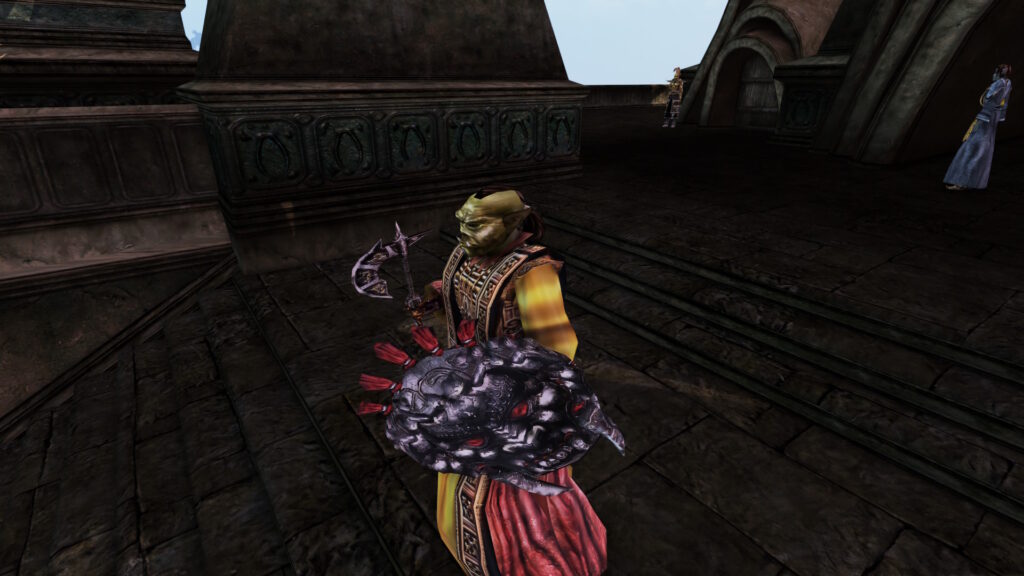
And there’s not just swords in Morrowind! There’s a much bigger variety of weapons and weapon types, including spears, darts and crossbows. Naturally, they’re spread all over the place, skillswise, and you can’t use a spear and a shield at the same time (though I’ve been told, once, that in mano-a-velothi combat, you’re more likely to take spear in each hand – shields are for fighting in formation). And unlike in more modern titles, you also don’t use the shield by yourself. Instead, you’re reliant on your block skill to grant you a block, oops!
99 problems and skills are like half of it
Skills, in general, is a semi-cursed system in Morrowind. You will have an array of player attributes that influence the character – but not all of them are equally important. Speed only affects movement speed – but covers foot movement, swimming, and levitating. Strength, on the other hand, is weapon damage, carrying capacity, starting health and stamina. Luck influences, however nebulously, each dice roll in the game. Considering that you can only raise these stats when leveling up, you are encouraged to spread around points to many baskets.
The good thing about actual skills is that they’re graded on class-appropriateness. Your class gives you five major and five minor skills, the rest being miscellaneous. The majors get +25 to their starting score, minors get +10, which is a lot in a system where everything starts at 5 and goes up to 100. Majors require less experience (that is, doing) to increase, miscellaneous need more, and only majors and minors count towards level increase. So that’s neat! You are no longer a hypercompetent superman, and while trying out a different build isn’t the sexiest reason to start a new play through, it increases replayability value somewhat while also enforcing class roles.
Another issue with skills is that skill increases don’t do anything interesting. It’s just number go up, making that invisible dice perform better. For weapons, it also increases damage. And sure, that is meaningful in a game that’s not infested with leveled enemies as you can actually see your skill affect the world.
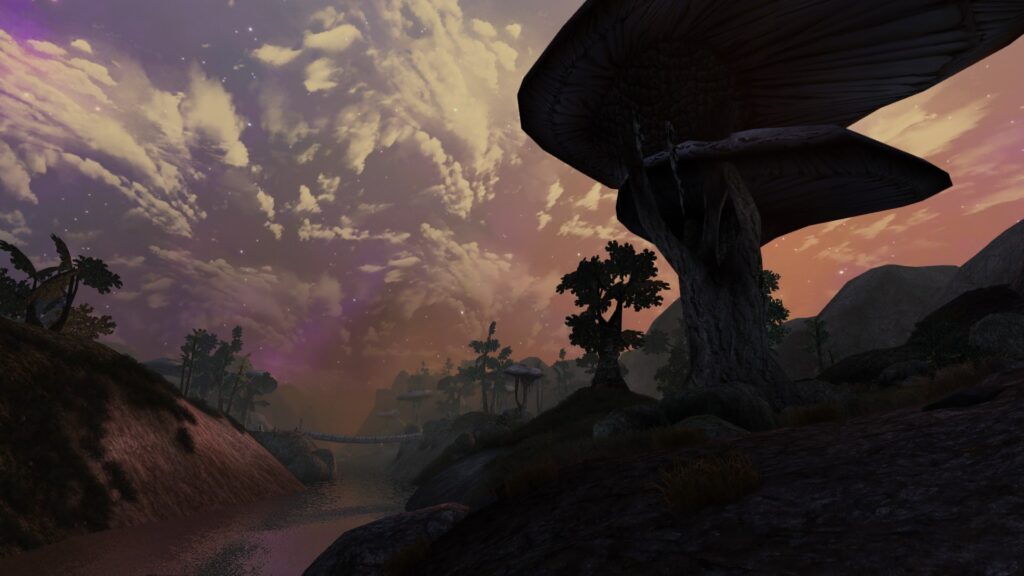
But generally, learning some tricks along the way – even if they’re a lil’ gamey like in Skyrim- would be fun. Heck, it is a thing with alchemy already (it’s all about getting to know more qualities of your materials), so it would be nice for, say, the axe skill to unlock more weird maneuvers and such. I’m sure there are more interesting ways to deal with trapped boxes than Morrowind’s “lockpicking before picking locks” or Skyrim’s “checking for a very conspicuous bit of string next to the box.”
Enchanting is the skill that stands out the most with both the best and the worst systems of Morrowind. On one hand, it’s like spell creation: freeform and allows you to mix and match effects from spells you already know, cast triggers, damage values, blast, etc.. On the other hand, the primary skill involved only makes the chance to enchant the item higher. Effects can quickly put the odds into negative percentages, so a low level character can’t just save-scum the system, but there are no other enticements. Prepare the enchantment and hope for the best.
Now, to take a turn completely sideways, I’ve always played Morrowind with Bloodmoon and Tribunal installed, so it’s hard for me to speak on what far-raging mechanical implications they have. On the more obvious side, the expansions provide you with two new areas to play with: the icy island of Solstheim and Mournhold, the provincial capital on the mainland. Mournhold stands out for several reasons: it’s a city with high walls where flight magic is prevented by Almalexia (to prevent players from going out into the continental Morrowind that nobody had the time and money to develop) and sewers are infested by boss-level goblins.
Those sewer goblins, basically naked and armed with crude weapons, are absolute beatsticks to challenge the presumably high-level players who bought Tribunal after beating Morrowind and Bloodmoon. Trouble is, you don’t need to be that high level to get into Mournhold, and you can get easily frustrated by getting ganked by Super Sewer Gobs. A more conceptual issue here: bare-ass goblins as a late game threat feels about as congruous Point Lookout’s naked tribals using the power of their oiled pecs to stab regular knives clean through power armor.
The difference here is that Fallout 3 is a much later game, so its excuses for bad game design are nil.
Speaking of game design: Morrowind Sharp is a collection of mods made to provide a vanilla experience of the game made more palatable by a bunch of visual, audio and UX improvements. It even patches out exploits in the game – exploits in a single player game, where nothing you do will affect another human being. It even lowers sell prices to make it harder to earn fat stacks of cash. This is the kind of approach to modding I can respect!
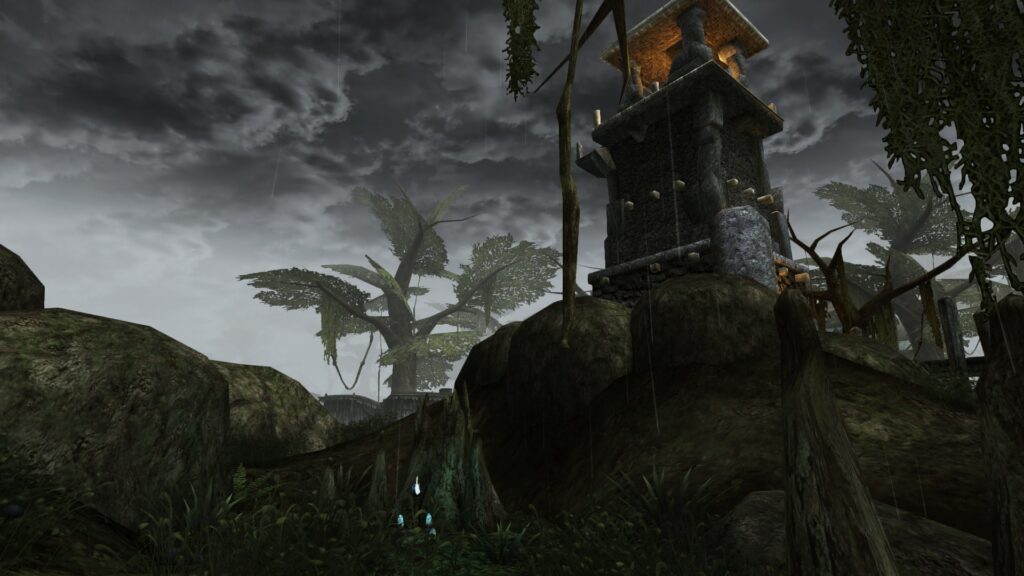
Morrowind Sharp is thus Morrowind, But Better without any weird modder shit. No new enemies, no new zones, no lore-accurate sexy armor, no lore-accurate HK416s, no reduction in Cliff Racers… Actually, while I heartily recommend Morrowind Sharp for anyone who wants to beat the game in TYOOL 2024+, I would advise hunting down mods that do SOMETHING about Cliff Racers and stamina.
Morrowind Sharp improves the visuals a lot. It’s an old game, and while the landscapes may look nice at a distance, it’s not that pretty up close. So the mod helps alleviate that issue. I don’t know how much it does for audio, but Morrowind always sounded good. Voiced dialogue is nearly non-existent, but that’s OK. We got the Morrowind theme to get us through the day. If you’re learning to play guitar, learn to play that!
Game good
There’s no need for a masochistic purist run to claim the accolade of beating Morrowind. In fact, you should beat – or rather experience – Morrowind just for yourself. It’s Vvardenfell as the setting and the awesome writing that allowed The Elder Scrolls 3: Morrowind to stand out in our minds all of those years. That the awful UX and some obvious gameplay missteps didn’t diminish its image just reinforces that point. Play Morrowind!

